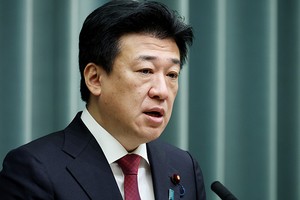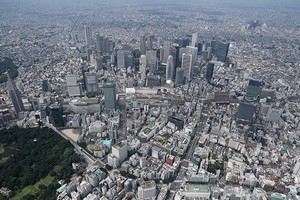THE ASAHI SHIMBUN
February 12, 2024 at 15:24 JST
 Residents attend a briefing held by the Defense Ministry in Uruma, Okinawa Prefecture, on Feb. 11. (Satsuki Tanahashi)
Residents attend a briefing held by the Defense Ministry in Uruma, Okinawa Prefecture, on Feb. 11. (Satsuki Tanahashi)
URUMA, Okinawa Prefecture—The Defense Ministry tried to reassure residents here about safety and other issues concerning a planned new Ground Self-Defense Force training site, but the explanation was met largely with skepticism.
The ministry held a briefing session for about 280 residents on Feb. 11 about the project planned in their city. Local neighborhood associations, concerned about noise and accidents, have already demanded that the plan be scrapped.
The GSDF training site, adjacent to a residential area, will be part of the “southwest shift” of Japan’s defense capabilities, with China in mind.
The ministry said it will buy a 20-hectare former golf course in fiscal 2024, conduct a survey design in fiscal 2025, and start construction for the GSDF training site in fiscal 2026.
The acquisition cost was included in the proposed budget for the new fiscal year and communicated to the Uruma city and Okinawa prefectural governments. The budget amount has not been disclosed because negotiations with landowners are pending.
The planned site is designed for helicopter operations and training of new SDF members. They will not be firing live ammunition.
“We will do our best to minimize the impact on the surrounding area,” Defense Minister Minoru Kihara said at a news conference.
During the briefing, ministry officials emphasized that “no U.S. military training is envisioned,” and that helicopters will only fly in time of disaster or emergency.
Some residents raised questions.
One said: “It is strange to give an explanation after the planning decision has been made. Will the residents’ opinions be reflected from now on?”
Another resident criticized the ministry’s explanation as “completely unreliable,” citing the fact that its plan to deploy missile and other units at a GSDF garrison in Yonaguni, Okinawa Prefecture, was decided after the coastal surveillance unit was set up.
The development of the Uruma training site was initiated after three revised security-related documents were issued in December 2022. The documents included a policy to upgrade the Naha-based 15th Brigade, with about 2,000 personnel, to a division with more SDF members.
“In terms of defense strategy, it is highly significant to have a training site near the troops,” a senior ministry official.
However, the planned site is surrounded by residential neighborhoods and a prefectural youth facility, where elementary, junior high, and high school students stay and study.
In January, two local neighborhood associations passed a resolution opposing the construction of the training site, citing concerns about noise and accident risks associated with helicopter drills.
A council consisting of 15 neighborhood associations in the former Ishikawa city also unanimously voted against the project.
A 71-year-old resident who lives nearby said the training site “will destroy our lives.”
“The noise and accidents caused by the U.S. military alone are unbearable, and it is outrageous that the SDF will further increase the burden with the base,” he said.
The planned site is also in the district of Miyamori Elementary School, where 18 people, including children, were killed when a U.S. military jet crashed in 1959, before Okinawa’s reversion to Japan.
Many people still remember the tragedy.
The 71-year-old man was a first-grader in the area at the time.
“Every time there is an accident involving the U.S. military, it brings back memories of those days. I fear that the same thing may happen again,” he said.
In addition, a surface-to-ship missile unit will be deployed in March at the GSDF Vice Camp Katsuren in Uruma, located about 15 kilometers southeast of the new training site.
Deployment of long-range missiles at the site, for possible strikes against enemy bases that are attacking Japan, is also being considered.
The ministry said it has not yet decided on the deployment site for such missiles. But some Uruma residents are concerned the area may become a target of other countries in the event of a military emergency.
Uruma Mayor Masato Nakamura has yet to indicate his approval or disapproval of the planned GSDF training site.
Some Uruma city assembly members affiliated with the Liberal Democratic Party are sympathetic to the neighborhood associations.
Transcending party lines, a group of city assembly members plans to submit a petition opposing the project to the February assembly session.
In recent years, the GSDF has opened garrisons in the Sakishima isles, including on Yonagunijima, Miyakojima and Ishigakijima islands.
Okinawa Governor Denny Tamaki said such moves make “the people of the prefecture feel danger and anxiety.”
Regarding the new training site in Uruma, Tamaki urged the ministry and the GSDF to “show respect for the wishes of the local community.”
(This article was written by Kaigo Narisawa and Satsuki Tanahashi.)




















A peek through the music industry’s curtain at the producers who harnessed social media to help their idols go global.
A series based on diplomatic documents declassified by Japan’s Foreign Ministry
Here is a collection of first-hand accounts by “hibakusha” atomic bomb survivors.
Cooking experts, chefs and others involved in the field of food introduce their special recipes intertwined with their paths in life.
A series about Japanese-Americans and their memories of World War II